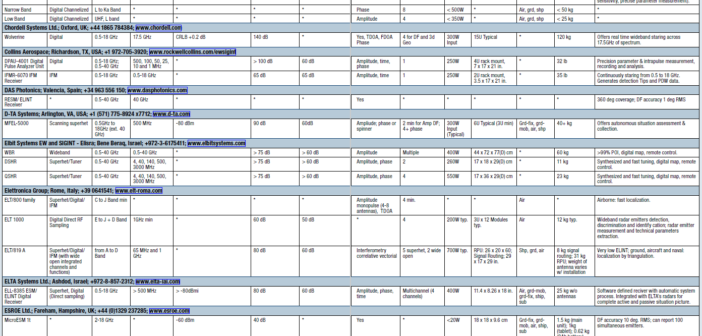– By Barry Manz –
Electronic intelligence (ELINT) receivers may not need to make split-second, life-or-death decisions like their radar warning receiver (RWR) counterparts, but that doesn’t make their job any easier or their design less complex. Since we last surveyed them two years ago, there’s a noticeable increase in their overall performance and capabilities in keeping pace with the radars they’re up against.

Click the image above to view the complete survey table. For the best viewing experience, open in PDF viewer and select “Two Page View” in Page Display settings.
The tasks required of an ELINT receiver have never been simple to execute, but today, they are far more difficult. The service life of a radar system is typically measured in decades rather than years. This means that an ESM or ELINT system must cover a growing list of radars – some new and some old – whose signatures can change over time as upgrades are implemented, components are replaced and their performance evolves with new technologies.
Different types of radars also have unique electromagnetic profiles, so a ballistic missile defense radar will differ from every other type, including missile seekers, and even radars of the same type will vary from one system to another. In addition, modern multimode, multifunction radars combine complex pulse modulation schemes with frequency agility, intra-pulse waveform changes, exotic waveforms such as pseudo-noise modulation, as well as lightning-fast changes to sidelobes, digital beamforming, and a variety of other deceptive techniques.
Worse yet are low-probability-of-intercept (LPI) radars, such as those using frequency-modulated continuous-wave (FMCW) and frequency-modulated interrupted continuous-wave (FMICW) that often cannot even be detected let alone identified and analyzed by older ESM and ELINT receivers. In short, while it may be possible to detect a radar, characterizing it can sometimes be next to impossible.
Some types of radars are also moving higher in frequency, well into the millimeter-wave region, which presents a unique set of challenges. At the same time, other radars are operating in the densely-populated electromagnetic environment between HF and about 6 GHz, which makes detection even more difficult and signifying a trend that will continue to become more problematic as commercial wireless services expand their footprint, even overlaying multiple services on the same frequencies.
To address all these challenges, ELINT receivers are exploiting technologies developed in the consumer market. These include very-high-performance host processors, ADCs and DACs that have high sampling rates, resolution, and spurious-free dynamic range (SFDR).
For many years, ELINT receivers relied almost exclusively on analog technology to perform functions at the front end, and signal analysis was performed by whatever digital technology was available when they were manufactured. In the latest systems, much of what was formerly performed in the analog domain is now performed digitally because of the extraordinary computational performance available from CPUs and hardware accelerators.
Even a quick look through the specifications within the following ELINT receiver survey table illustrates how these marvels of analog and digital technology have been enhanced. Many now have instantaneous bandwidths of 1 GHz, operating frequencies from HF through 40 GHz, and superheterodyne, as well as digital, receiver architectures in a single system.
Spurious-free dynamic range (SFDR) of at least 50 dBc is a given, and total dynamic range is often greater than 90 dB. All have multiple interfaces for transferring signals to high-speed signal recorders for detailed analysis, and many are supported by analysis software and the ability to become part of complete, single-vendor platforms in form factors compatible with different operating environments.
This month’s survey includes nearly 40 ESM and ELINT receivers from 23 companies. ♦
Click here to view the complete survey table. For the best viewing experience, open in PDF viewer and select “Two Page View” in Page Display settings.
If you enjoyed this article, please share. If you would like to read more articles like this one, we encourage you to join the AOC to receive a copy of JED every month.






